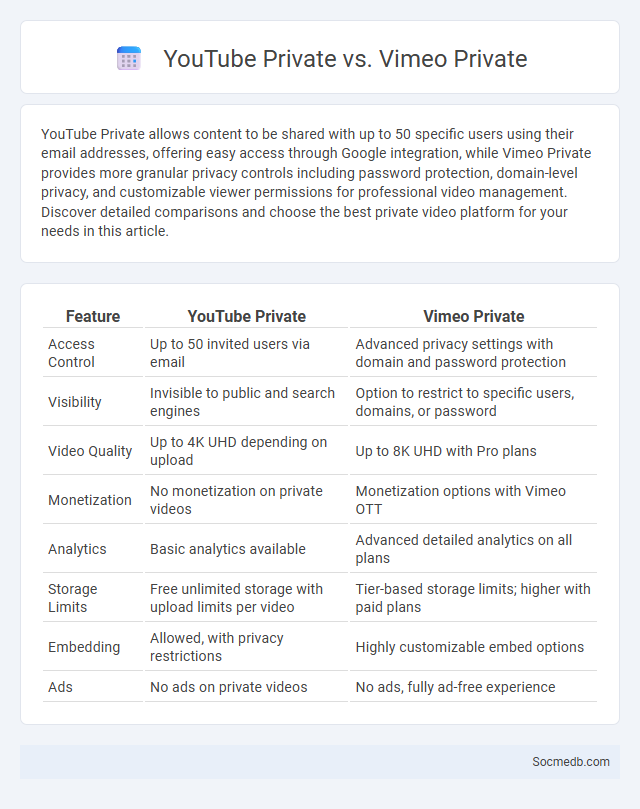
Photo illustration: YouTube Private vs Vimeo Private
YouTube Private allows content to be shared with up to 50 specific users using their email addresses, offering easy access through Google integration, while Vimeo Private provides more granular privacy controls including password protection, domain-level privacy, and customizable viewer permissions for professional video management. Discover detailed comparisons and choose the best private video platform for your needs in this article.
Table of Comparison
| Feature | YouTube Private | Vimeo Private |
|---|---|---|
| Access Control | Up to 50 invited users via email | Advanced privacy settings with domain and password protection |
| Visibility | Invisible to public and search engines | Option to restrict to specific users, domains, or password |
| Video Quality | Up to 4K UHD depending on upload | Up to 8K UHD with Pro plans |
| Monetization | No monetization on private videos | Monetization options with Vimeo OTT |
| Analytics | Basic analytics available | Advanced detailed analytics on all plans |
| Storage Limits | Free unlimited storage with upload limits per video | Tier-based storage limits; higher with paid plans |
| Embedding | Allowed, with privacy restrictions | Highly customizable embed options |
| Ads | No ads on private videos | No ads, fully ad-free experience |
Introduction to Private Video Hosting
Private video hosting offers secure platforms for sharing video content with controlled access, ensuring only authorized viewers can watch. Businesses and creators use these services to protect sensitive information, maintain brand exclusivity, and enhance user experience through privacy settings and analytics. Advanced encryption and customizable permissions make private video hosting essential for confidential marketing, training, and internal communications on social media.
Overview of YouTube Private Video Features
YouTube private videos can only be viewed by users who are explicitly invited by the video owner, ensuring maximum control over content visibility. These videos do not appear in search results, channel lists, or subscriber feeds, reinforcing privacy and selective sharing. Private video settings support collaboration and discreet content distribution, making them ideal for sensitive or limited-audience material.
Vimeo Private Video Options Explained
Vimeo's private video options provide customizable privacy controls, allowing you to restrict access by password, domain, or specific users, ensuring your content is shared securely. You can choose between private link sharing, where only recipients with the link can view, or setting videos to be accessible solely on designated websites. These privacy settings give you full control over who sees your videos, making Vimeo ideal for confidential or exclusive social media content distribution.
Understanding General Private Video Settings
Social media platforms offer various private video settings that control who can view your content, including options like Friends Only, Specific People, or Only Me. Understanding these settings helps protect your privacy while allowing you to share personal moments selectively with trusted audiences. Make sure to regularly review and adjust your video privacy settings to align with your comfort level and security needs.
Security and Privacy: YouTube vs Vimeo
YouTube employs advanced encryption protocols and multi-factor authentication to safeguard user data, while its extensive user base demands robust content moderation to prevent privacy breaches. Vimeo prioritizes privacy by offering customizable access controls and ad-free viewing, appealing to creators seeking enhanced content security. Both platforms implement regular security updates, but Vimeo's focus on niche professional communities provides a more controlled environment compared to YouTube's mass-market ecosystem.
Audience Control and Access Management
Social media platforms offer robust audience control and access management features that help you customize who can view and interact with your content. Tools like privacy settings, block lists, and group segmentation enable precise control over audience reach, enhancing security and user experience. Effective access management minimizes unwanted engagement and protects your personal information from unauthorized users.
Monetization and Content Restrictions
Monetization on social media platforms often involves ad revenue sharing, sponsored content, and subscription models, enabling creators to generate consistent income. Content restrictions vary widely, with platforms enforcing guidelines on hate speech, misinformation, and copyright infringement to maintain user safety and comply with legal regulations. Understanding these policies helps you maximize earnings while avoiding penalties or account suspension.
Platform Usability and Integration
Social media platforms enhance user experience through intuitive interface design and seamless integration with third-party applications, boosting overall engagement and functionality. Features like single sign-on (SSO), API connectivity, and cross-platform synchronization allow users to navigate and manage content efficiently across devices. Optimized platform usability and integration drive higher user retention rates and expand social media ecosystems.
Pricing and Storage Considerations
Social media platforms often offer tiered pricing models based on features, storage, and usage levels, enabling you to choose plans that align with your budget and content needs. Storage considerations impact the quality and amount of media you can upload; platforms like Facebook and Instagram provide limited free storage, while premium plans on services like YouTube offer expanded capacity for video content. Evaluating these pricing and storage options ensures your social media strategy remains cost-effective and scalable as your online presence grows.
Choosing the Best Private Video Platform
Choosing the best private video platform involves evaluating security features, user access controls, and content encryption to protect your videos from unauthorized viewing. Look for platforms with customizable privacy settings, real-time analytics, and seamless integration with your existing tools for enhanced user experience. Ensuring your video content remains confidential while maintaining ease of sharing is crucial to safeguarding your brand and audience trust.
 socmedb.com
socmedb.com